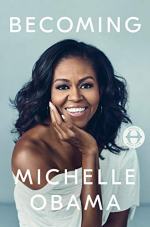|
This section contains 626 words (approx. 2 pages at 400 words per page) |

|
Becoming Summary & Study Guide Description
Becoming Summary & Study Guide includes comprehensive information and analysis to help you understand the book. This study guide contains the following sections:
This detailed literature summary also contains Topics for Discussion on Becoming by Michelle Obama.
The following version of this book was used to create this Study Guide: Obama, Michelle. Becoming. Crown, 2018. First Edition.
Michelle Obama’s autobiography is divided into three main sections, each of which corresponds to what she sees as a particular phase of her life. The preface and epilogue that flank these sections provide a present tense introduction and conclusion, written as though Obama is speaking to the reader before launching into past tense storytelling mode. Throughout, Obama weaves anecdotes from her life together with emotional reflection and commentary on social realities.
The autobiography follows a largely chronological telling of Obama’s life. She begins with her childhood and young adult years, a section she titles “Becoming Me.” Obama recounts growing up on the South Side of Chicago, with a particular emphasis on her family and school. She uses her South Side anecdotes to reflect on themes like race and class. This section also includes Obama’s college years and her first job as a lawyer in Chicago. She concludes with meeting Barack and, on the final page of the section, their first kiss.
The second section is titled “Becoming Us,” and outlines the development of Obama’s relationship with Barack. She explores the experience of falling in love. Obama also delves into trials the couple faced as their marriage progressed. She mentions the couples’ struggles getting pregnant and their decision to attend marriage counseling at a time when they were stretched thin by professional and marital responsibilities. She reflects on the challenges of blending professional and familial responsibilities.
Simultaneously, she explores her own professional formation. Obama recounts her career transition – from following the path of “success” to following her heart and passions. Significantly, this section also introduces Barack’s political career, and the advent of Obama’s life as a politician’s wife. She opens up about the ways in which she found both Barack’s schedule and the viciousness of politics to be draining, and the professional choices she made in order to facilitate his political career.
The last section, “Becoming Us,” covers Barack’s election as President of the United States and the family’s eight years in the White House. In this section, Obama describes initiatives she took on as First Lady, including healthy eating and exercise campaigns aimed at children, outreach with military families and service members, support for girls’ education, and projects to allow local students access the White House. She ties these initiatives to larger social issues.
Obama also reflects on the personal challenges she confronted while First Lady. Not least, she was recognized entirely for her relationship to her husband, though, though her initiatives, she aimed to carve a space for herself. Throughout this section, Obama reflects on the ways she was hurt by politically motivated personal attacks on her and Barack, and laments the extent to which she was evaluated based on her appearance. She also ties these challenges to contemporary social realities.
Finally, Obama’s family-centered attitude is on display in this section. She endeavors to maintain as much normalcy as possible for herself and her children. She also strives to set boundaries between political life and family life, although she also recognizes the powerful role her family can play as national and international figureheads, and the ways in which they can serve as models.
The epilogue focuses on her reasons for writing the autobiography and her definition of “becoming.” This section also briefly reflects on Donald Trump’s election. Trump’s election, she acknowledges, marks a departure from the Obamas’ years in the White House. Despite this, Obama concludes with hope. She writes that sharing her non-traditional “success” story is meant to motivate others, and that “becoming” is a process which is never complete.
Read more from the Study Guide
|
This section contains 626 words (approx. 2 pages at 400 words per page) |

|



